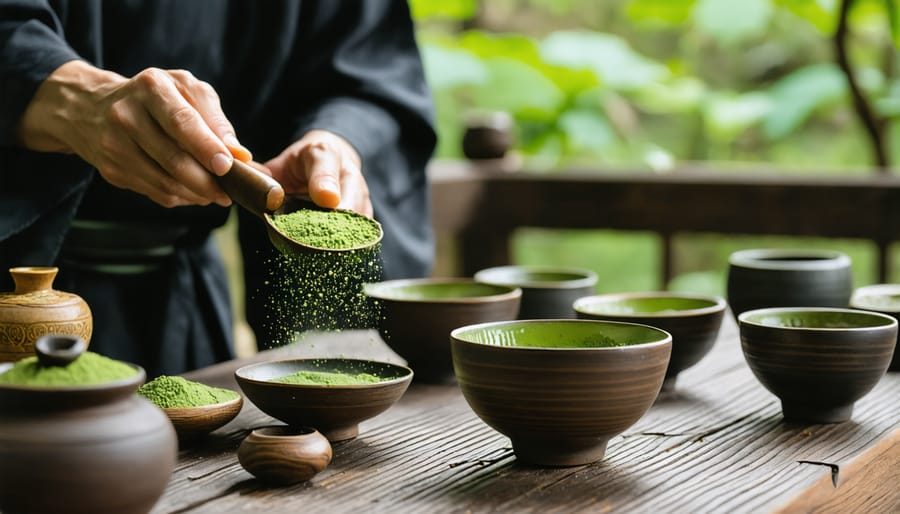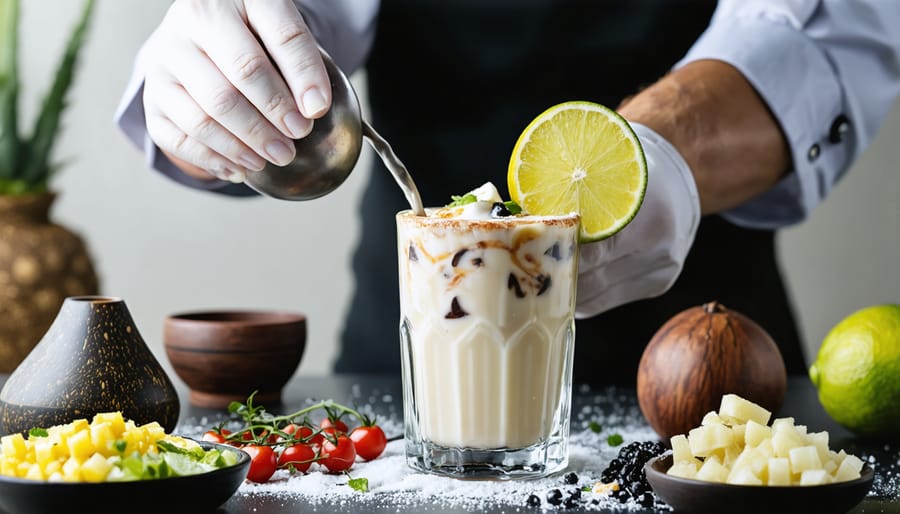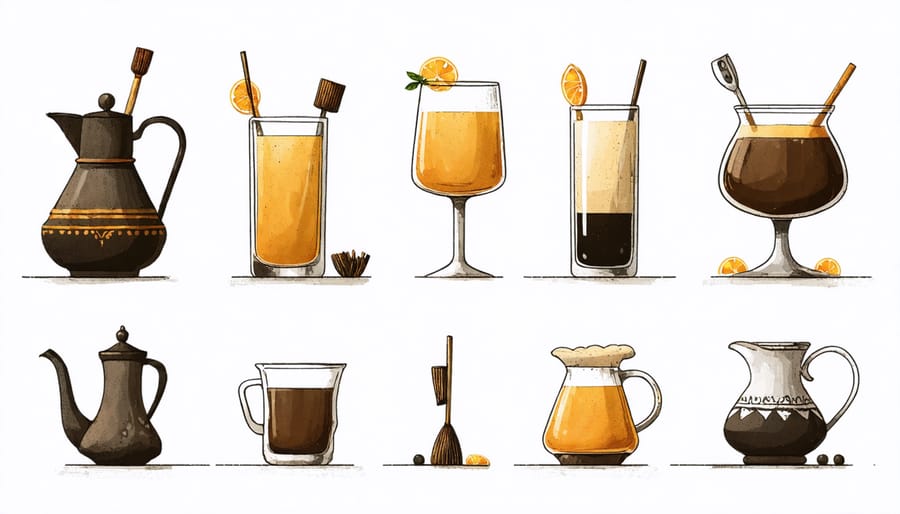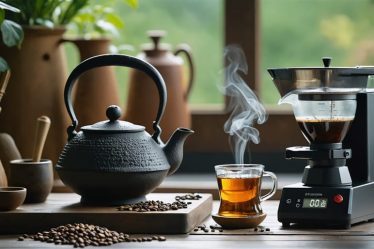
Pour yourself into a journey where every sip tells a story of tradition, celebration, and human connection. From the ceremonial matcha bowls of Japan to the communal mate gourds passed around in Argentina, cultural drinks have shaped societies and brought people together for thousands of years. These beloved beverages do more than quench thirst—they serve as liquid time capsules, preserving centuries of wisdom, ritual, and artistry in every carefully crafted glass.
I discovered this profound connection firsthand while sharing chai with a family in Mumbai, watching as three generations worked in harmony to brew the perfect blend of spices and memories. Their grandmother’s eyes sparkled as she explained how each ingredient carried its own story, passed down through countless morning rituals and afternoon gatherings.
Today, these cultural drinks are experiencing a renaissance as modern enthusiasts seek authentic connections in an increasingly digital world. Whether it’s Mexican pulque’s ancient Aztec roots or Korean makgeolli’s humble origins, these beverages offer us more than just flavors—they provide a passport to understanding different cultures, celebrating diversity, and creating meaningful moments of connection in our own lives.
Join me as we explore these liquid treasures that have been carefully preserved and lovingly shared across generations, continents, and cultures.
The Art of Cultural Drink-Making
Time-Honored Techniques
There’s something magical about watching a Turkish coffee maker slowly heat fine grounds in a copper cezve, or seeing a Japanese tea master perform an intricate matcha ceremony. These time-honored beverage traditions carry centuries of wisdom in their careful movements and precise techniques.
Each culture has developed its unique methods, perfected through generations of practice. In Mexico, the molinillo whisk creates the perfect froth for traditional chocolate drinks, while in India, chai wallahs master the dramatic ‘pulling’ of tea to achieve the perfect blend of spices and milk. These techniques aren’t just about preparing drinks – they’re about preserving cultural heritage and creating moments of connection.
What makes these traditional methods so special is how they engage all our senses. The rhythmic sound of tea being poured from height in Morocco, the aromatic steam rising from Korean suju being warmed, or the visual poetry of Chinese gongfu cha – each element has been carefully choreographed over centuries to create an experience that transcends mere refreshment.
Sacred Ingredients
In many cultures, certain ingredients hold deep spiritual and symbolic meaning, transforming ordinary beverages into sacred expressions of tradition and ritual. Take, for instance, the Japanese matcha ceremony, where the vibrant green tea powder represents harmony and respect. The process of preparing this revered drink involves traditional infusion techniques passed down through generations.
Similarly, the Aztec’s use of cacao beans in ceremonial drinks wasn’t just about taste – these precious seeds were considered gifts from the gods, often used in religious ceremonies and royal festivities. In Indian culture, the holy basil (Tulsi) added to chai isn’t just for flavor; it’s believed to purify the body and spirit.
Even seemingly simple ingredients like honey in Mediterranean cultures or agave in Mexican traditions carry profound significance. These sweeteners weren’t merely taste enhancers but were often considered nature’s sacred gifts, used in drinks to honor deities and mark important life events.
Today, many of these sacred ingredients continue to be cherished, offering us a beautiful connection to ancient wisdom and cultural heritage through every thoughtful sip.
Celebrated Cultural Beverages Around the World
Asian Tea Ceremonies
There’s something magical about the way tea ceremonies bring people together across Asia, creating moments of mindfulness and connection. In Japan, the revered chanoyu (tea ceremony) transforms the simple act of preparing matcha into an art form, where every graceful movement carries deep meaning. I’ll never forget watching my first Japanese tea ceremony, where the host’s deliberate movements turned routine into ritual.
Chinese tea ceremonies, known as gongfu cha, celebrate the pure appreciation of tea’s subtle qualities. The practice involves multiple small infusions in tiny cups, allowing participants to experience how the tea’s character evolves with each steeping. The ceremony often features prized oolong or pu-erh teas, served with elegant precision using traditional clay teaware.
Korean tea ceremonies, called darye, reflect the peninsula’s unique cultural heritage, emphasizing harmony with nature and respect for elders. The ceremony often takes place in beautiful tea houses surrounded by gardens, where green tea is prepared with a focus on natural beauty and seasonal awareness.
What makes these ceremonies truly special isn’t just the tea itself, but the way they create space for reflection and connection. Whether you’re participating in an elaborate ceremony or simply sharing tea with friends, these traditions remind us to slow down and savor both the drink and the moment. Many modern tea enthusiasts are now incorporating elements of these ceremonies into their daily routines, finding peace in these ancient practices.

Latin American Heritage Drinks
When I first encountered atole at a Mexican friend’s holiday celebration, I was instantly captivated by its warm, comforting embrace. This traditional Latin American drink, made from corn masa, water, and various flavorings, has been nurturing souls for centuries. Whether enjoyed plain or enhanced with chocolate (champurrado), vanilla, or fruit, atole remains a beloved breakfast and evening companion throughout Mexico.
Moving south to Peru, chicha holds a special place in Andean culture. The most famous variety, chicha morada, gets its stunning purple hue from blue corn and is infused with pineapple, apple, cinnamon, and cloves. During my travels through Cusco, I discovered that traditional chicha de jora, a fermented corn beer, still follows ancient Incan preparation methods and plays a vital role in community gatherings.
Brazil’s coconut water culture deserves special mention – it’s not just a trendy health drink here but a daily ritual. Whether sipped straight from fresh green coconuts on Rio’s beaches or mixed into creative cocktails, it represents the vibrant spirit of Brazilian refreshment.
Throughout Latin America, these heritage drinks tell stories of indigenous wisdom, colonial influences, and modern adaptations. They’re more than just beverages; they’re liquid traditions that connect generations and communities, offering us a taste of history with every sip.
European Artisanal Traditions
There’s something magical about European drink traditions that have been lovingly passed down through generations. From the sun-drenched vineyards of France to the cozy pubs of Ireland, each region tells its own story through its signature beverages.
Take Italy’s limoncello, for instance – a zesty liqueur that started as a beloved family recipe along the Amalfi Coast. Local grandmothers still pride themselves on their secret ratios of lemon zest to sugar, creating liquid sunshine that perfectly captures Mediterranean joy in a glass.
In Germany, the art of beer-making is considered nothing less than a cultural treasure. The famous Reinheitsgebot (beer purity law) of 1516 still influences craft brewers today, who honor tradition while experimenting with modern techniques. Each region boasts its own distinctive style, from Munich’s robust lagers to Berlin’s tart wheat beers.
The Dutch have given us genever, the juniper-flavored predecessor to modern gin. Originally sold in pharmacies as medicine, it evolved into a cherished social drink, traditionally served in tulip-shaped glasses filled to the brim – requiring a ceremonial first sip while bending over the bar!
Meanwhile, in Eastern Europe, the tradition of infusing spirits with herbs and spices has created remarkable drinks like Hungarian Unicum and Czech Becherovka. These bitter liqueurs, originally crafted by medieval monks and physicians, remain popular both as digestifs and cultural symbols.
Modern Revival of Heritage Drinks
Contemporary Interpretations
Today’s innovative mixologists and beverage enthusiasts are reimagining traditional cultural drinks in exciting new ways, reflecting our evolving modern drink culture. Take the classic Mexican horchata, for instance – creative bartenders are now infusing it with espresso shots for a morning pick-me-up or adding premium spirits for an elevated cocktail experience.
Asian bubble tea has undergone perhaps the most dramatic transformation, with artisanal shops offering everything from brown sugar variations to cheese foam toppings. Traditional chai isn’t far behind, with trendy cafes crafting golden turmeric lattes and lavender-infused chai that honor the original while appealing to contemporary tastes.
Even ancient drinks like kombucha have found new life in craft breweries, where traditional fermentation methods meet modern flavoring techniques. Think hibiscus-rose kombucha or blueberry-lavender variations that make these health-focused beverages more approachable for modern palates.
What’s particularly exciting is how these contemporary interpretations are making cultural drinks more accessible while respecting their origins. Many creators are working directly with traditional communities to ensure authenticity while innovating, creating beautiful fusion beverages that tell stories of both heritage and evolution. This thoughtful approach allows us to experience the best of both worlds – time-honored traditions with modern twists that speak to today’s diverse tastes.

Preserving Traditions
In a world of mass production and instant gratification, there’s something magical about watching artisans preserve centuries-old drink-making traditions. From the misty mountains of Japan, where tea masters meticulously perform ceremonies passed down through generations, to the sun-drenched vineyards of Italy where families still crush grapes by foot, these cultural guardians are keeping history alive one sip at a time.
I recently met Maria, a third-generation horchata maker in Valencia, Spain, who shared how her grandmother taught her to carefully select and soak tiger nuts using the same earthenware vessels her family has owned for decades. It’s this dedication to authenticity that makes traditional beverages so special.
Modern artisans are finding innovative ways to balance time-honored methods with contemporary needs. Many are embracing sustainable beverage crafting while maintaining traditional techniques. They’re documenting recipes, mentoring apprentices, and creating community workshops to ensure these precious skills aren’t lost to time.
What’s particularly heartening is seeing young people take interest in these traditions. From Korean makgeolli brewing collectives to Mexican pulque preservation societies, new generations are stepping up to carry these cultural treasures forward, adding their own thoughtful innovations while respecting the core practices that make these drinks unique.
Creating Your Own Cultural Drink Experience

Essential Tools and Ingredients
Creating cultural drinks at home doesn’t require a professional bar setup – just a few essential tools and quality ingredients will get you started on your global beverage journey. I’ve learned through experience that investing in the right basics makes all the difference.
Start with a reliable blender for smoothie-like drinks and a sturdy muddler for crushing herbs and spices. A fine-mesh strainer is crucial for filtering traditional drinks like Mexican horchata or Indian lassi. Don’t forget a set of measuring tools – precision matters when crafting authentic beverages!
For ingredients, stock your pantry with versatile basics like honey, different types of sugar (including palm sugar for Asian drinks), and a selection of loose-leaf teas. Fresh herbs like mint, basil, and lemongrass are game-changers for many cultural drinks. Keep coconut milk, lime juice, and ginger root on hand – they’re staples in beverages across multiple cultures.
My personal must-have is a collection of small glass bottles for storing homemade syrups and infusions. These allow you to prep traditional flavoring agents like rose water or cardamom syrup ahead of time. A set of authentic serving vessels adds to the experience – think Mexican clay cups for horchata or small glass cups for Turkish tea.
Remember, you don’t need everything at once. Start with the basics and gradually build your collection as you explore different cultural drinks. Many of these tools serve multiple purposes, making them worthy investments for your kitchen.
Respectful Appreciation
When exploring cultural drinks, it’s essential to approach them with genuine curiosity and respect. I remember my first experience with Japanese tea ceremony – I was nervous about making a cultural faux pas, but my host’s gentle guidance helped me understand that authentic appreciation starts with an open mind and humble heart.
Start by learning about the beverage’s cultural significance before tasting. Understanding why a drink is important to a community helps you connect with its deeper meaning. For instance, many traditional drinks are tied to celebrations, spiritual practices, or historical events that have shaped entire societies.
When sharing these drinks with others, acknowledge their origins and avoid referring to them as “exotic” or “weird.” Instead, use their proper names and learn to pronounce them correctly. If you’re recreating cultural drinks at home, try to source authentic ingredients and follow traditional preparation methods when possible.
Be mindful of sacred or ceremonial drinks that may have specific protocols around their consumption. Some beverages are reserved for special occasions or may only be prepared by certain community members. Always ask questions respectfully and be grateful for the opportunity to learn from those who share their cultural knowledge.
Remember that appreciating cultural drinks isn’t about collecting experiences like souvenirs – it’s about building bridges of understanding and respect between communities.
As we raise our glasses to the rich tapestry of cultural drinks worldwide, we’re reminded that each sip tells a story of tradition, community, and celebration. These beverages are more than just refreshments; they’re living links to our ancestors and windows into diverse cultures. Whether it’s sharing mate in Argentina, participating in a Japanese tea ceremony, or discovering your local cultural drink traditions, these experiences connect us to both our roots and each other.
I encourage you to step out of your comfort zone and explore these cultural treasures. Visit ethnic markets, attend cultural festivals, or invite friends to share their traditional drinks with you. By embracing and preserving these beverage traditions, we keep cultural heritage alive and create meaningful connections across communities. Remember, every cultural drink you discover is an opportunity to travel the world through your taste buds and create lasting memories with loved ones.



